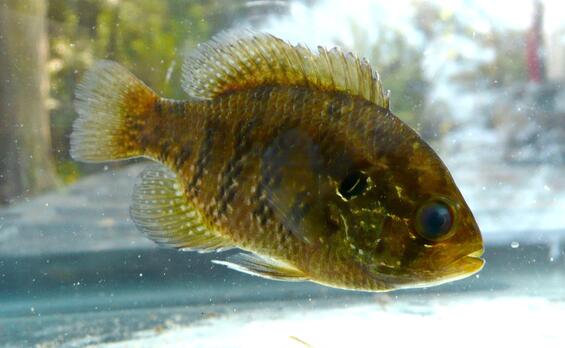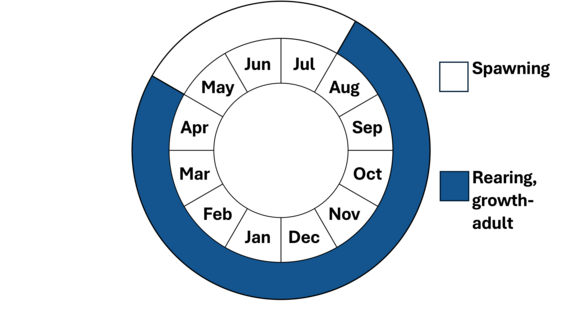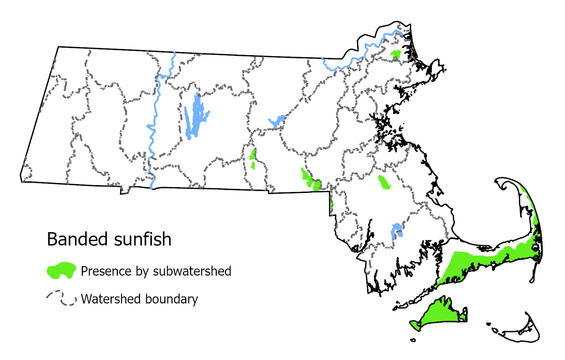- Scientific name: Enneacanthus obesus
- Species of Greatest Conservation Need (MA State Wildlife Action Plan)
Description

Banded sunfish collected during a fisheries survey of the Millers River in 2008.
The banded sunfish is a small, stout-bodied fish, and the only local sunfish with a rounded tail fin and short, round pectoral fins. It is olive-green to brown with numerous small bronze, silver-green, and light blue spots on the body, and 5 to 8 dark vertical bars. This species rarely exceeds 2 to 3 inches in length, although specimens over 4 inches have been recorded from Massachusetts. Banded sunfish usually live three to four years, although five-year-old specimens have been recorded. They feed on a wide variety of small aquatic invertebrates, including cladocerans, copepods, dipterans, and amphipods. The relative size and seasonal abundance of prey greatly influence their diet.
Life cycle and behavior

Banded sunfish spawn from late spring through summer. They construct nests of sand and gravel or among aquatic vegetation. The home range of banded sunfish is restrictive, and they generally do not move great distances.
Population status
The population status of banded sunfish is currently unknown. They are somewhat widespread in coastal rivers along the Atlantic Coast, from southern Maine to Florida. They are found in select Massachusetts rivers during standard fish sampling.
Distribution and abundance
This species is widespread in most of eastern Massachusetts but known only from a few sites on Cape Cod and two locations on Martha's Vineyard. In the inland portion of the state, banded sunfish have been seen only in the upper Chicopee Drainage (Burnshirt and Ware rivers), Nashua River, and the upper Millers River drainages. These Chicopee and Millers populations are most likely the result of stream capture (likely due to erosion, glaciation, or changes in elevation that redirected the river’s flow) from the Merrimack Basin. This species is still common in the proper habitat but has declined with urban sprawl as small, swampy wetlands were drained.

Data from 1999-2024 from annual surveys.
Habitat
Banded sunfish live in quiet backwaters, swamps, and ponds. They are frequently associated with heavy aquatic vegetation and have been observed to thrive in naturally acidic waters.
Healthy habitats are vital for supporting native wildlife and plants. Explore habitats and learn about conservation and restoration in Massachusetts.
Threats
The major threat to this species is the loss of its shallow wetland habitats to development and/or pollution.
Conservation
Protecting coastal and low-gradient riverine habitat, river connectivity, and water quality may be the most important conservation strategy for banded sunfish.
Research needs
Banded sunfish are regularly observed during state fisheries surveys
Management
Currently, there are no specific management strategies or management plans for banded sunfish.
Research needs
Identifying habitat improvement, protection, and restoration opportunities, as well as better understanding habitat requirements, may help managers identify strategies to maintain healthy populations.
References
This species description was adapted, with permission, from: Karsten E. Hartel, David B. Halliwell, and Alan E. Launer.
2002. Inland Fishes of Massachusetts. Massachusetts Audubon Society, Lincoln, Massachusetts.
Contact
| Date published: | April 10, 2025 |
|---|